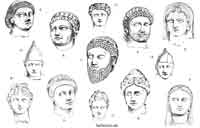.
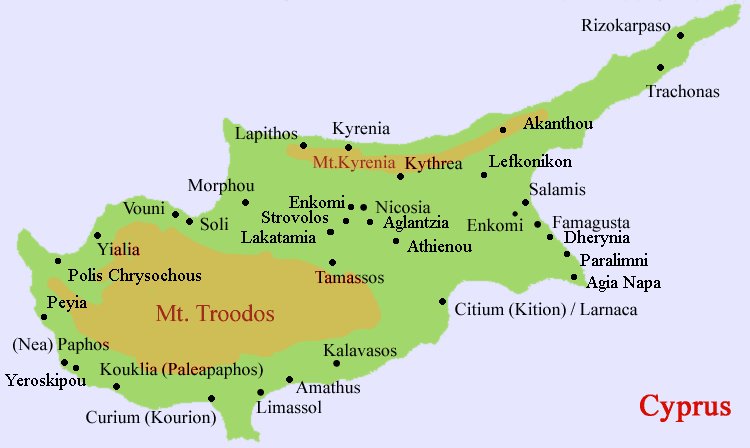
Salamis is an ancient city on the east coast of Cyprus, at the mouth of the river Pedieos, 6 km North of Famagusta.
istory
The mythical founder of Salamis is Teucer, son of Telamon who could not return home after the Trojan war because he had failed to avenge his brother Aias.

Amphora , Salamis Cyprus, 6th century BC
The earliest archaeological finds go back to the 11th century (Late Bronze Age III). Children's burials in Canaanite jars indicate a Phoenician presence. A harbour and a cemetery from this period have been excavated. The town is mentioned in Assyrian inscriptions as one of the kingdoms of Ia'. The first coins were minted in the 6th century, following Persian prototypes.

A fragment of 3rd century fresco at the Salamis gymnasium [Source]
In 450 BC Salamis was the site of a simultaneous land and sea battle between Athens and the Persians. (This is not to be confused with the earlier Battle of Salamis in 480 BC between the Greeks and the Persians at Salamis in Attica.)
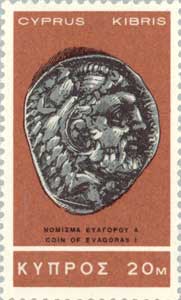
The most important ruler of the kingdom of Salamis was Evagoras (410–-374 BC), who became ruler of the whole island, and won its independence from the Persian Empire. Salamis was afterwards besieged and conquered by Artaxerxes III.
After Alexander the Great destroyed the Persian Empire, Ptolemy I of Egypt ruled the island of Cyprus. He forced the last king of Salamis, Nikokreon, who had been the Ptolemaic governor of the island, to commit suicide in 311 BC, because he did not trust him any more. Nikokreon is supposed to be buried in one of the big tumuli near Enkomi. Salamis remained seat of the governor.
In 306 BC Salamis was the site of a naval battle between the fleets of Demetrius I of Macedon and Ptolemy I of Egypt. Demetrius won the battle and captured the island.
In Roman times, Salamis was part of the Roman province of Cilicia. The seat of the governor was relocated to Paphos. The town suffered heavily during the Jewish rising of AD 116/117. Several earthquakes led to the destruction of Salamis at the beginning of the 4th century ( 332 and 342 AD). The town was rebuilt under the name of Constantia by Constantine II (337-361 AD) and became Episcopal seat. The silting of the harbour led to a gradual decline of the town. Salamis was finally abandoned during the Arab invasions of the 7th century AD after destructions by Muawija. The inhabitants moved to Arsinoë (Famagusta).
Sights

The gymnasium, Salamis [Source]
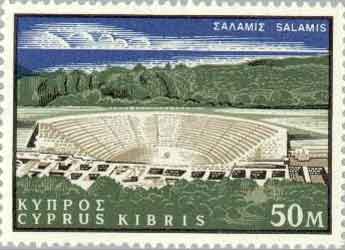
Theater in Salamis, Cyprus
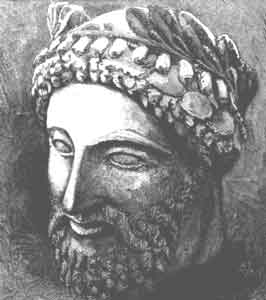
Head of a Priest from Salamis
Most of the extant ruins date to the Roman period. There are very extensive ruins. The amphitheatre, and the gymnasium have been extensively restored. Numerous statues are displayed in the central court of the gymnasium most of which are headless, destroyed by Christians. While a statue of Augustus originally belonged here, some columns and statues originally adorned the theatre and were only brought here after an earthquake in the 4th century. The theatre is of Augustean date. It could house up to 15.000 spectators. It was destroyed in the 4th century.
There are baths, public latrines (for 44 users), various little bits of mosaic, a harbour wall, a Hellenistic and Roman agora and a temple of Zeus that had the right to grant asylum. Byzantine remains include the basilica of Bishop Epiphanos (AD 367–403). It served as the metropolitan church of Salamis. St. Epiphanos is buried at the southern apse. The church contains a baptistry heated by hypocausts. The church was destroyed in the 7th century and replaced by a smaller building to the south. The town was supplied with water by an aquaeduct from Kyhrea, destroyed in the 7th century. The water was collected in a large cistern near the Agora.
The necropolis of Salamis covers ca. 7 km² to the west of the town. It contains a museum showing some of the finds. Burials date from the geometric to the Hellenistic period. The best known burials are the so-called Royal-Tombs, containing chariots and extremely rich grave gifts, including imports from Egypt and Syria.
Helicon of Salamis (Cyprus)
Pnytagoras, King of Salamis
References
- Vassos Karageorghis, Salamis in Cyprus, Homeric, Hellenistic and Roman (1969), ISBN 0500390061.
- Vassos Karageorghis is the world’s leading authority on Cypriote Archaeology
|
Archaeological sites , ancient cities in Cyprus Aetokremnos | Alassa | Apliki | Choirokoitia | Chytri | Gialia Monastery | Enkomi | Kalavasos-Tenta | Kastros | Katalymata ton Plakoton | Klimonas | Kourion | Kyrenia ship | Lapithos | Marion | Marki Alonia | Mnemata Site | Paphos | Salamis | Shillourokambos | Soli | Tamassos | Tombs of the Kings (Paphos) | |
| Ancient Greece
Science, Technology , Medicine , Warfare, , Biographies , Life , Cities/Places/Maps , Arts , Literature , Philosophy ,Olympics, Mythology , History , Images Medieval Greece / Byzantine Empire Science, Technology, Arts, , Warfare , Literature, Biographies, Icons, History Modern Greece Cities, Islands, Regions, Fauna/Flora ,Biographies , History , Warfare, Science/Technology, Literature, Music , Arts , Film/Actors , Sport , Fashion --- |
Retrieved from "http://en.wikipedia.org/"
All text is available under the terms of the GNU Free Documentation License

